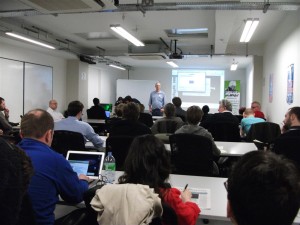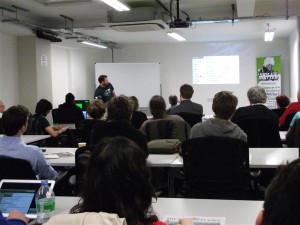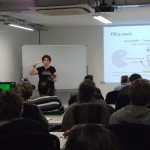
This month’s talks at the London WordPress usergroup took place at Skills Matter in the City of London.
Talk 1 – Favourite plugins
Graham Armfield presented his favourite WordPress plugins and invited others to share theirs too. They are linked to in the comment to this article. As SlideShare isn’t the quickest way to see them, I’ve picked out a few here:
Relevanssi
Replaces the default search with a partial-match search that sorts results by relevance. It also indexes comments and shortcode content.
wp-twitter-feed
Place a twitter feed on your site with shortcode
WordPress Keyboard Accessible Dropdown Menus Plugin
Graham’s own plugin to help make dropdown menus work without a mouse.
Point and Stare CMS Functions
This plugin generates special functions to convert your WordPress install into a CMS, add security and generally white label the admin.
WP Better Emails
Adds a good looking HTML template to all WP default plain/text emails and lets you set a custom sender name and email address.
WP-Table Reloaded
Creates a data table layout from the admin area.
Watermark Reloaded
Adds a configurable watermark to your images as they are uploaded
Visual Form Builder
Dynamically builds froms with validation
Our own picks can be seen on this blog, on the right hand side.
Talk 2 – Multi-lingual WP
Rich Holman discussed methods, things to look for and consider, design considerations and plugins that can help you build a multi-lingual site with WordPress.
In a detailed and well explained talk, Rich took us through the pitfalls and shortcuts to building WordPress sites in more than one language. The easy option is just to install seperate copies of WordPress for each language. This approach works well if you can build common elements to your theme, and it’s appropriate for the project. This is best if the content on the different sites does not need to be equivalent. A more common requirement is for the same content to be readable in several languages. This will involve several considerations.
Design
Allow enough space in menus and other areas. Verbose languages like German can really mess up your lovely neat menu!
Be aware you are designing blind. Often the designer won’t know the other languages and good communication is the key.
Right to Left (RTL) languages could mean moving your content around – for example moving the sidebars from right to left.
HTML Language codes. Make sure you declare the language being used in your underlying code. This way plugins like Facebook’s Like button will automatically change it’s text to match.

Development
The admin screen in WordPress already have translations.
Theme translations use .po and .mo files. Use Poedit to create and manage. Some of the translation plugins available will read your theme and create translation files ready for editing.
Problem areas
- Tags and Taxonomy
- Queries – one home page had over 1000 queries to load.
- Widgets
- Plugins
- Feeds
- RSS
Plugins for Multi-Language WordPress sites
- WPML (paid plugin)*
- xili-language
- qtranslate*
- polylang
- google ajax translate
- multisite language switcher
* Rich’s recommendations
Rich advised that switching plugins is not a good idea – they don’t really work together or store data in a consistent way.
If you actually need translations to be done for your content, Rich suggested ICanLocalize, which is part of the WPML family. Rates are around $0.07 per word. One final word from the audience was a note to check the font you are using has support for all the characters in your chosen languages. Many fonts from providers such as Google Fonts and Typekit only contain the Latin character set.
Talk 3 – Human Centred Design
Tammie Lister presented a call to action to bring back human focused design.

Tammie related her views on how the web recently has become very structured what with grids, templates and stock photography proliferating. She called on designers and developers to “make it personal”. Inspired by Aarron Walters work on MailChimp, and using examples such as the Twitter “Fail Whale” and Google Logos she showed how even large companies can humanise their image. Another personal dislike of Tammie’s is seeing “Submit” on forms. When in real life does anyone “submit” something? Jargon like this should be excised from the new web.
WordPress allows content to be created freely so stock phrasology and stock photography can be avoided, plus it supports custom error pages, custom headers and backgrounds in many themes, and language files in many themes allow the nuts and bolts to be humanised. Tammie suggests customising the Admin part of WordPress so that users you are designing for only get what they need, and removing the clutter that gets put in by default.
One member of the audience took a counter view and said how he’d tried in the past to get clients to go for a jargon-free website but because the client and their audience were within the same related sphere, some jargon was inevitable.
Social
As always after the talks proper, discussions and informal networking carried on ’til closing time at the nearby pub.
I’ve uploaded my slides from the Favourite Plugins discussion last night so that everyone can see the ones we recommended. You can find the presentation slides at: http://www.slideshare.net/coolfields/wordpress-london-favourite-plugins
The podcasts for the three talks can be seen on the Skills Matter site unfortunately there was a technical issue and Rich’s talk has a lot of noise on it.